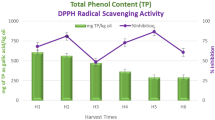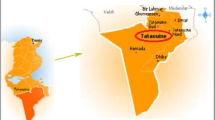Abstract
There is a need to verify the quality of organically produced olive oils and to compare them to conventional ones. The objective of this study was to assess possible differences in nutritional quality between agronomic practices in Picual and Hojiblanca olive oil varieties at different stages of olive ripeness. The results showed that organic versus conventional cultivation did not consistently affect acidity, peroxide index or spectrophotometric constants of the virgin olive oils considered in this study. On the contrary, phenol content, oxidative stability, tocopherol content and fatty acid composition were affected by the agronomical practices. Principal component analysis indicated that linolenic acid and β-tocopherol were mainly responsible for discriminating Hojiblanca organic oils, whereas total phenols, palmitoleic acid and α-tocopherol were the major contributors to differentiating Picual conventional oils. Lignoceric and stearic acids were related to oils from unripe and ripe olive fruits, respectively. Long-term experiments are required to confirm these results.





Similar content being viewed by others
References
CAPMA (2012) Aforo de olivar. Campaña 2012–2013.Consejería de Agricultura, Pesca, y Medio Ambiente, Junta de Andalucía, Sevilla, Spain. (in Spanish). http://www.juntadeandalucia.es/agriculturaypesca/portal/servicios/estadisticas/estadisticas/agraria/index.html (verified January 17, 2015)
Landa BB, Montes-Borrego M, Aranda S, Soriano MA, Gómez JA, Navas-Cortés JA (2014) Soil factors involved in the diversity and structure of soil bacterial communities in commercial organic olive orchards in Southern Spain Environ Microbiol Rep 6:196–207
Chhabra R, Kolli S, Bauer JH (2013) Organically grown food provides health benefits to Drosophila melanogaster. PLoS One 8:e52988
Barański M, Srednicka-Tober D, Volakakis N, Seal C, Sanderson R, Stewart GB, Benbrook C, Biavati B, Markellou E, Giotis C, Gromadzka-Ostrowska J, Rembiałkowska E, Skwarło-Sońta K, Tahvonen R, Janovská D, Niggli U, Nicot P, Leifert C (2014) Higher antioxidant and lower cadmium concentrations and lower incidence of pesticide residues in organically grown crops: a systematic literature review and meta-analyses. Br J Nutr 112:794–811
Dangour AD, Dodhia SK, Hayter A, Allen E, Lock K, Uauy R (2009) Nutritional quality of organic foods: a systematic review. Am J Clin Nutr 90:680–685
Jimenez B, Sánchez-Ortiz A, Lorenzo ML, Rivas A (2014) Effect of organic cultivation of Picual and Hojiblanca olive varieties on the quality of virgin olive oil at four ripening stages. Eur J Lipid Sci Technol 116:1634–1646
Gutiérrez F, Arnaud T, Albi MA (1999) Influence of ecological cultivation on virgin olive oil quality. J Am Oil Chem Soc 76:617–621
Anastasopoulos E, Kalogeropoulos N, Kaliora AC, Kountouri A, Andrikopoulos NK (2011) The influence of ripening and crop year on quality indices, polyphenols, terpenic acids, squalene, fatty acid profiles, and sterols in virgin olive oil (koroneiki cv.) produced by organic versus non-organic cultivation method. Int J Food Sci Technol 46:170–178
Ninfali P, Bacchiocca M, Biagiotti E, Espoto S, Servilli M, Rosati A, Montedoro G (2008) A 3-year study on quality, nutritional and organoleptic evaluation of organic and conventional extra-virgin olive oils. J Am Oil Chem Soc 85:151–158
Rosati A, Cafiero C, Paoletti A, Alfei B, Caporali S, Casciani L, Valentini M (2014) Effect of agronomical practices on carpology, fruit and oil composition, and oil sensory properties, in olive (Olea europaea L.). Food Chem 159:236–243
Martínez JM, Muñoz E, Alba J, Lanzon A (1984) Informe sobre la utilización del analizador de rendimientos “Abencor”. Grasas y Aceites 26:379–385
European Commission Regulation (EEC) No. 2568, 91 of 11 (1991) On the characteristics of olive oil and olive-residue oil and methods of analysis. Off J European Union L 248:1–83
IOOC: Document COI/T.20/DOC. 29. International Olive Oil Council, Madrid
Gutiérrez F (1989) Determination of the oxidative stability of virgin olive oils: comparison of the active oxygen and the Rancimat methods. Grasas y Aceites 40:1–5
IUPAC. 1987. International Union of Pure and Applied Chemistry. Determination of tocopherol and tocotrienols in vegetable oils and fFats by HPLC: Method 2.432. In Paquot C, Haufenne A, (eds) Standard Methods for the Analysis of Oils, Fats and Derivatives. Blackwell, Oxford, 2432/1-2432/7
Baccouri O, Bendini A, Cerretani L, Guerfel M, Baccouri B, Lercker G, Ben Zarrouk M, Miled DD (2008) Comparative study on volatile compounds from Tunisian and Sicilian monovarietal virgin olive oils. Food Chem 111:322–328
García-González DL, Aparicio-Ruiz R, Morales MT (2014) Chemical characterization of organic and non-organic virgin olive oils. Oilseeds & fats crops and Lipids 21:D506
Martínez Nieto L, Hodaifa G, Lozano JL (2010) Changes in phenolic compounds and Rancimat stability of olive oils from varieties of olives at different stages of ripeness. J Sci Food Agr 90:2393–2398
Youssef NB, Zarrouk W, Carrasco-Pancorbo A, Ouni Y, Segura-Carretero A, Fernandez-Gutierrez A, Daoud D, Zarrouk M (2010) Effect of olive ripeness on chemical properties and phenolic composition of Chetoui virgin olive oil. J Sci Food Agr 90:199–204
Beltrán G, Jiménez A, Aguilera MP, Uceda M (2000) Phenolic fraction analysis by HPLC of Arbequina virgin olive oils. Relationship with bitterness K225 and oil stability. Grasas y Aceites 51:320–324
Dabbou S, Dabbou S, Chehan H, Brahmi F, Taticchi A, Servili M, Hammami M (2011) Chemical composition of virgin olive oils from Koroneiki cultivar grown in Tunisia with regard to fruit ripening and irrigation regimes. Int J Food Sci Technol 46:577–585
Samman S, Chow J, Foster M, Ahmad Z, Phuyal J, Petocz P (2008) Fatty acid composition of edible oils derived from certified organic and conventional agricultural methods. Food Chem 109:670–674
Author information
Authors and Affiliations
Corresponding author
About this article
Cite this article
Jimenez, B., Sánchez-Ortiz, A., Lorenzo, M.L. et al. Effect of Agronomical Practices on the Nutritional Quality of Virgin Olive Oil at Different Ripening Stages. J Am Oil Chem Soc 92, 1491–1501 (2015). https://doi.org/10.1007/s11746-015-2710-8
Received:
Revised:
Accepted:
Published:
Issue Date:
DOI: https://doi.org/10.1007/s11746-015-2710-8




